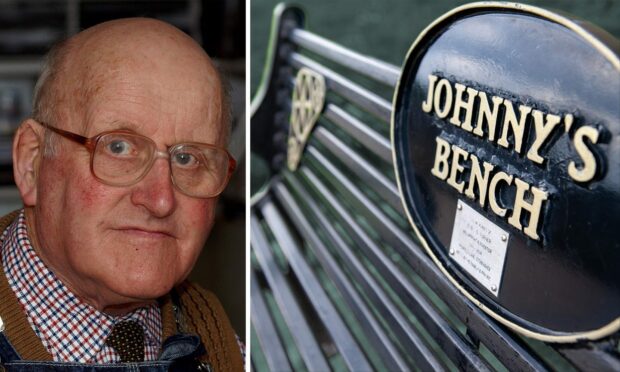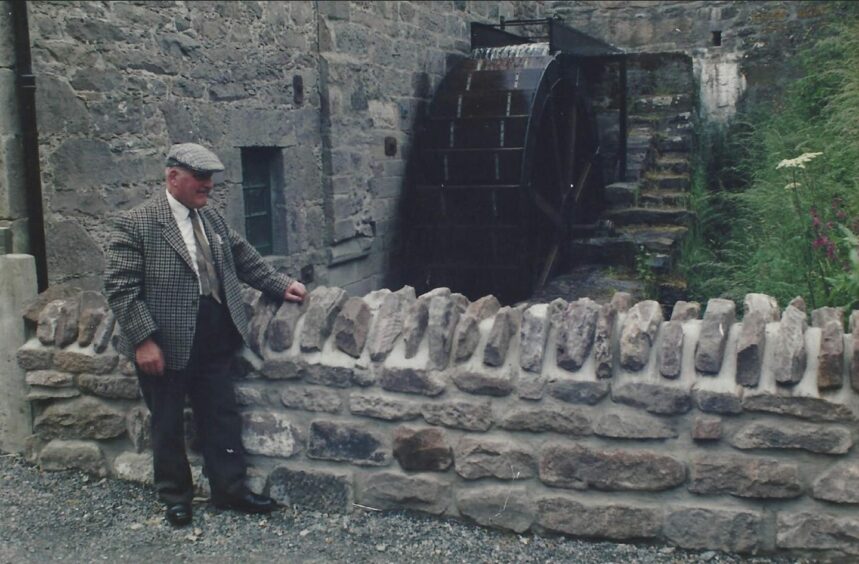Embellished with pulleys and pinions, a memorial bench in Stonehaven holds within its iron bars the story of an inventor and engineer who lived and worked in the town for 80 years.
As part of our Place to Remember series uncovering the stories behind north-east memorial benches, we find out about Johnny Turner, a millwright whose patented inventions are still being used today.
Son of Stonehaven
Located near Ironfield Lane a distinctive memorial bench pays tribute to John “Johnny” Turner. Born on July 24 1928, at Clochanhill Farm, he would have been 95 last month.
The son of Annie Gordon Turner and John Harrow Turner – of Ann Street- Johnny began working with his father when he was just eight years old in the family millwright business.
The business – located on Ironfield Lane, worked with distilleries, mills, factories, railways, fisheries, farmers and others. It was based on the site of what is now Turner’s Court.
Patented inventor
By the age of 14 Johnny left school to join the family business.
Like his father – an “old school millwright” who had patented a potato harvester concept – he also developed a curious mind, able to solve problems.
A time-served wright with the firm, by the mid 1950s Johnny developed three agricultural patents himself, inventing components for harvesters still being used today.
In Stonehaven he built his own harvesters, demonstrating them against competitors at events across the UK.
In need of financial backing at the time, he sold one of his patents. One of which was commercialised by a manufacturer. A huge success for them, Johnny never fully benefitted financially from his creations.
A time to change
In 1957 Johnny married Emily Ann Smith. Though they later divorced the couple had one son, Alan.
“My grandfather wasn’t the most progressive,” explained Alan, “so when he retired my dad – Johnny – started considering work elsewhere.
“For a long time Turner’s were working with distilleries and such but as time went on how these places operated began to change. Dad didn’t want to keep going knowing the skills they had may no longer be useful.
At that juncture Johnny became employed by Grampian Regional Council.
A role which saw him work for the local authority for over 20 years, he was part of the welding and blacksmiths department, then worked as a joiner, until he was 65.
Benholm Mill
Before he properly retired he was sub-contracted, by Grampian Regional Council, to Whittaker Engineering in Stonehaven. There he worked on the building, layout and installation of the mechanical milling machinery at Benholm Meal Mill.
Such was the standard of his work that the new working wheel was given John’s name as his handiwork still appreciated now.
Pulleys and pinions
Johnny passed away in September 2014 following a cancer diagnosis.
Before his death – and ever the organiser and designer – he shared with his son designs he had drawn for his headstone.
Comprising pulleys and pinions, the same design – by Johnny himself – features on his memorial bench.
“In his later life my father was a well-known and popular character on the Stonehaven beach front area. That’s why as a family we decided to commission a memorial bench.
“With the help of Aberdeenshire Council this was positioned on the beach front between Cowie Lane and Ironfield Lane. It’s where he lived and worked for over 80 years,” said Alan, also an engineer.
“I can see the bench from my office – and from what was once my dad’s workshop. And I’ve had great joy over the years in seeing people stop to read the plaque on the bench, and then be able to explain to them that Johnny was my father.”



